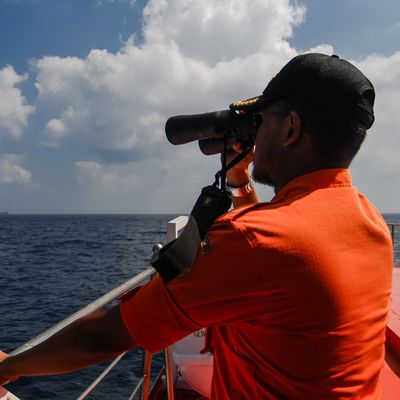
This much we know: Out in a remote stretch of the southern Indian Ocean, a 379-foot exploration ship called the Seabed Constructor has started searching an area that may be the final resting place of MH370, the Malaysia Airlines jet that vanished in 2014 with 239 souls aboard. The ship arrived in the search zone on Sunday, and, given the rate at which the vessel’s swarm of eight autonomous subs can scan the seabed, could finish its work in as little as three weeks.
Just about everything else about the project is shrouded in mystery, including who’s carrying it out and why.
The search for MH370 was done and dusted as of January 2017, when Australia announced that its three-year, $150 million effort to scan 46,000 square miles of seabed had found no sign of the plane. The search zone had been demarcated by scientists using signals sent between the plane and a communications satellite after it disappeared from radar. The signals suggested that the plane turned southwest of the Malacca Strait and flew in a straight line until it ran out of fuel, then nosedived into the sea. At the start of the search officials were so confident in their analysis that one boasted that they had a bottle of Moët “chilling nicely” — but once they were proved wrong, Australia seemed eager to close the case and move on.
In a final report issued last October, officials lamented their failure to find the plane, a turn of events they labeled “almost inconceivable.” To explain the plane’s absence, officials surmised that something peculiar must have happened. Perhaps whoever was flying the plane descended and then flew in circles for a while before heading south. If that was the case, the plane could have ended up in a 25,000-square-kilometer area to the north of the completed search area. But Malaysia, the country ultimately responsible for the search, didn’t feel confident enough in the idea to green-light a continuation.
Then last August a previously unknown company called Ocean Infinity stepped forward and offered to restart the search on its own dime, with payment only if it found the plane. The deal seemed to be a no-brainer for Malaysia, but negotiations dragged on until earlier this month. Under the terms of the final deal Malaysia will pay Ocean Infinity anywhere from $20 million to $70 million, depending on how much seabed it has to search.
This kind of deal is called “no cure — no pay” in the salvage business. Under this kind of arrangement a salvor might, for example, receive a portion of the crude oil recovered from a grounded tanker but get nothing if it fails to produce anything. The current situation falls far outside this model, of course. But given Malaysia’s sense that it had just wasted a lot of money on a pointless search, “no cure — no pay” might have been the only way for Ocean Infinity to lure it into a contract.
It’s a high-risk gambit. The payout is not considerably large considering that the effort will likely cost tens of millions of dollars to mount. And the odds are long. Much of the new search zone was already scanned during an early phase of the first seabed search, before Australian scientists refined their calculations and moved their focus farther south. In the highest-priority part of the new search zone, for instance, everything within 20 miles of the arc along which the plane sent its final satellite signal has already been searched and ruled out. It’s not clear how the plane could have flown farther than that, since at that moment it was plummeting straight down toward the sea.
Given the long odds, it’s striking that anyone would want to roll the dice.
Some have speculated that the effort is essentially an act of charity by deep-pocketed philanthropists. But it would seem strange for do-gooders to keep their operation shrouded in as much secrecy as the group behind the Seabed Constructor has — basically we know nothing about it.
Another possibility is that the backers’ ultimate motive is to garner publicity for Ocean Infinity so that it can win contracts in the undersea-exploration industry. There are two flaws in this theory though: This industry is in a severe slump right now, with few jobs available, and, it’s a sector where capabilities and price, not branding and exposure, are the keys to gaining customers.
A third explanation is that the backers don’t think their odds of finding the plane are long — either because they are clueless or because they possess some information that the rest of us don’t.
Or perhaps there is something else going on that we could never guess from the outside. That’s entirely possible, too — if a little unnerving.
The saga of MH370 is full of unanswered questions, and this is another one.
Knowing the identity of the backers might help clarify the motives. But Ocean Infinity’s publicist will only say that “it’s a private company owned by its shareholders and we don’t wish to say any more on that.” The Australian reported that Ocean Infinity is owned “by a number of British investors.”
Ocean Infinity was registered in Delaware on June 9, 2017, and in Texas 21 days later. It leases Seabed Constructor from Swire Seabed, a subsidiary of the London-based Swire Group conglomerate, and employs a Louisiana company to operate the swarm of undersea robots that will scan the seabed.
The company’s Texas filing lists its directors as Oliver Plunkett, 45, and Ross Hyett, 64. Both men are based in London and work in the wealth-management field, finding investments for high-net-worth clients. Each serves on the board of a private company owned by Paul Roderick Clucas Marshall, a British hedge-fund manager worth an estimated $683 million. Marshall has long been active in the Liberal Democrats party (and is the father of Mumford & Sons member Winston Marshall). Marshall’s publicist denies that he is behind Ocean Infinity, however.
As the story unfolds new strange angles continue to emerge. With Seabed Constructor approaching the search zone last weekend, users of a ship-tracking site noticed that another vessel, the 312-foot Maersk Mariner, had left the Australian port of Fremantle in Western Australia and was heading for a rendezvous. The Mariner is a so-called anchor-handling vessel designed to support offshore oil drilling. The purpose of its current mission is so far unclear.
As with everything else, Ocean Infinity is staying tight-lipped. The company releases official statements only infrequently, apparently preferring to communicate via leaks to a small number of journalists and independent researchers who will occasionally drop a tidbit on Twitter or personal websites. Some of these people claim to have been told the nature of the project’s funding off the record and refuse to divulge it; others say they have chosen not to ask. This, unfortunately, is par for the course for the shadowy saga of MH370. If the vanishing of 239 passengers and crew is a profoundly discomfiting eventuality, so too is the years-long bungling by search officials, and the chronic inability of the world’s journalists and investigators to press for satisfying answers.
Given the strangeness of the mission and the consensual fog that lies over it, it’s frankly hard to know what to make of Ocean Infinity’s mission. But this state of uncertainty can’t go on forever. Malaysia has given the company a hard deadline of 90 days to wrap the project up. By then we should either have achieved some clarity, or another strange chapter of this saga will have been wrapped up and shipped off to cold storage.
And so that, belatedly, will be that. When they wrote their report delineating the new 25,000-square-kilometer search zone, Australian scientists wrote that if the plane is not found in this area they have no other ideas about where to look. No theories about what happened, no explanation as to why — they’ll just have to close their files once more and shrug, as baffled as when they began.






























